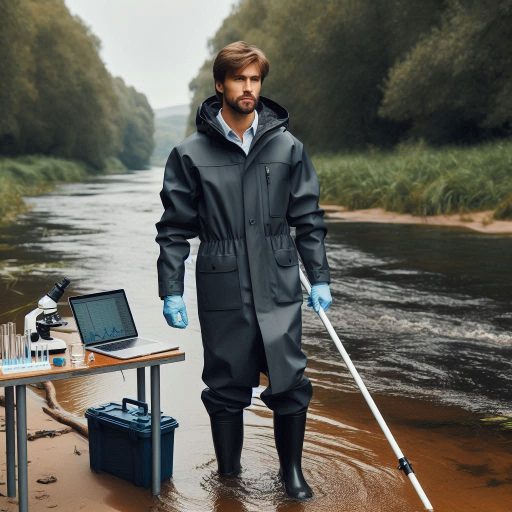Introduction
Hydrology and environmental science are two distinct yet interconnected fields of study.
Hydrology focuses on the distribution, movement, and properties of water in the environment.
It examines water cycles, groundwater, and the impact of water on ecosystems and human activities.
This field is essential for understanding how water interacts with natural systems and is vital for effective water management.
On the other hand, environmental science encompasses a broader range of topics.
It includes air quality, soil health, climate change, and the impact of human activities on the environment.
Environmental scientists study how these factors interact and contribute to ecological challenges.
They aim to develop strategies for preserving ecosystems and ensuring a sustainable future for all living organisms.
Understanding the key differences between hydrology and environmental science is crucial for students and professionals alike.
Each field has unique methodologies, objectives, and applications that address specific environmental challenges.
Recognizing these distinctions can help individuals choose the right career path and approach problems effectively.
For example, hydrologists often utilize modeling and statistical analysis to study water systems, while environmental scientists may use a more interdisciplinary approach.
Definition of Hydrology
Explanation of What Hydrology Is
Hydrology is the scientific study of water in all its forms.
It examines the distribution, movement, and properties of water on Earth.
Hydrologists analyze water’s interactions with the environment and human activities.
They assess how water cycles through different ecosystems and how it affects land and life.
This field plays a crucial role in understanding our planet’s most vital resource, water.
Focus on the Study of Water Resources, Water Quality, and the Water Cycle
Hydrology primarily focuses on three core areas: water resources, water quality, and the water cycle.
Water resources encompass the assessment and management of freshwater supplies.
Hydrologists evaluate how much water is available for consumption, agriculture, and industry.
They consider factors such as precipitation, surface water, and groundwater levels.
Water quality is another critical aspect of hydrology.
Hydrologists monitor contaminants and pollutants in water bodies.
They assess how these substances affect ecosystems and human health.
Ensuring safe drinking water and maintaining healthy aquatic environments is vital for public health and sustainability.
The water cycle is a fundamental concept in hydrology.
It describes how water moves through the atmosphere, land, and oceans.
Hydrologists study processes like evaporation, condensation, and precipitation.
Understanding these processes helps predict water availability and informs water management strategies.
The Various Subfields Within Hydrology
Hydrology consists of several subfields, each specializing in different aspects of water science.
Surface hydrology focuses on water movement and distribution on land.
It examines rivers, lakes, and runoff patterns.
Groundwater hydrology, on the other hand, investigates water found beneath the Earth’s surface.
It looks at aquifers, water tables, and the interaction between groundwater and surface water.
Another subfield is hydrogeology, which explores the relationship between geology and water resources.
Hydrogeologists study how rock formations influence groundwater flow and quality.
They play a crucial role in managing groundwater supplies for agriculture and urban areas.
Hydrometeorology combines hydrology and meteorology to understand how weather affects water systems.
This subfield analyzes precipitation patterns, evaporation rates, and their impact on water resources.
Hydrometeorologists provide valuable data for flood forecasting and drought assessments.
Lastly, ecohydrology focuses on the interactions between water and ecosystems.
It studies how aquatic environments respond to changes in water availability and quality.
Ecohydrologists work on projects related to wetland restoration and habitat conservation.
Basically, hydrology is a vital field that focuses on the study of water in all its forms.
It examines water resources, quality, and the water cycle.
With various subfields, hydrology plays an essential role in sustainable water management.
Understanding these key differences helps clarify the unique contributions of hydrology compared to environmental science.
Read: U.S. Cities with the Most Opportunities for Environmental Scientists
Definition of Environmental Science
Explanation of What Environmental Science Is
Environmental science is an interdisciplinary field that studies the environment and its various components.
It combines knowledge from multiple disciplines to understand complex environmental issues.
This field addresses the interactions between natural systems and human activities.
Environmental scientists seek to identify and solve problems that affect ecosystems and human health.
Focus on the Study of the Environment and Its Interactions with Human Activities
One primary focus of environmental science is the study of ecosystems.
Scientists analyze how different species interact with each other and their habitats.
They examine how human activities impact these natural systems.
For example, pollution from industries can harm local wildlife and disrupt ecosystems.
Environmental science also investigates resource management.
Scientists assess how resources like water, air, and soil are used and conserved.
They develop strategies for sustainable use to ensure these resources remain available for future generations.
By understanding human impacts, environmental scientists can create effective policies and practices to mitigate negative effects.
Another critical aspect of environmental science is climate change.
Scientists study the causes and consequences of climate change.
They analyze how rising temperatures affect weather patterns, ecosystems, and human health.
By understanding these changes, environmental scientists can recommend actions to reduce greenhouse gas emissions.
The Multidisciplinary Approach in Environmental Science
The multidisciplinary approach is a defining characteristic of environmental science.
This field draws on knowledge from various disciplines, including biology, chemistry, geology, and sociology.
By integrating different perspectives, environmental scientists can address complex issues comprehensively.
For example, a project studying water quality may involve hydrologists, chemists, and public health experts.
Hydrologists assess water movement and distribution, while chemists analyze contaminants.
Public health experts evaluate the impacts on community health.
This collaborative effort leads to more effective solutions for environmental challenges.
Moreover, environmental science often involves engaging with policymakers and communities.
Scientists communicate their findings to inform decision-makers.
They also work with communities to promote sustainable practices.
By fostering collaboration, environmental science seeks to create lasting positive change.
Therefore, environmental science is a vital field focused on understanding the environment and human interactions.
It addresses complex issues through a multidisciplinary lens.
By studying ecosystems, resource management, and climate change, environmental scientists contribute to sustainability and environmental protection.
Understanding these key differences between hydrology and environmental science enhances our ability to tackle environmental challenges effectively.
Both fields play essential roles in preserving our planet for future generations.
Read: Environmental Scientist vs. Ecologist: Roles and Differences in the US
Key Differences in Focus
Hydrology Focuses Specifically on Water Resources and Water-Related Processes
Hydrology is the scientific study of water in all its forms.
It examines the distribution, movement, and properties of water.
Hydrologists analyze how water interacts with the environment and ecosystems.
They focus on water resources, including surface water, groundwater, and precipitation.
One key aspect of hydrology is understanding the water cycle.
Hydrologists study evaporation, condensation, precipitation, and runoff.
They examine how these processes affect water availability and quality.
This knowledge helps in managing water resources effectively.
Hydrologists also investigate water-related issues like flooding and droughts.
They use models to predict water behavior under various conditions.
This predictive capability is vital for urban planning and disaster management.
Hydrology plays a crucial role in ensuring sustainable water use.
In addition, hydrologists conduct field studies to gather data.
They collect information on streamflow, soil moisture, and groundwater levels.
This data informs water management strategies and policies.
Hydrologists collaborate with engineers, urban planners, and environmental scientists to develop effective solutions.
Environmental Science Has a Broader Focus on All Aspects of the Environment
In contrast, environmental science encompasses a wider range of topics.
It studies the interactions between physical, chemical, and biological components of the environment.
Environmental scientists examine air quality, soil health, and biodiversity.
Their work addresses various environmental issues, including pollution and climate change.
Environmental science integrates knowledge from multiple disciplines.
It includes biology, chemistry, geology, and meteorology.
This interdisciplinary approach helps scientists understand complex environmental problems.
By considering various factors, they can develop comprehensive solutions.
One major focus of environmental science is sustainability.
Scientists seek to understand how human activities impact the environment.
They explore ways to minimize negative effects and promote ecological balance.
This focus on sustainability drives research and policy-making in the field.
Environmental scientists also engage in conservation efforts.
They study ecosystems and their inhabitants to protect biodiversity.
Their research informs conservation strategies and habitat restoration projects.
These efforts are essential for maintaining healthy ecosystems and natural resources.
In review, while hydrology and environmental science overlap, their focus areas differ significantly.
Hydrology centers on water resources, whereas environmental science addresses broader environmental concerns.
Understanding these differences enhances collaboration between professionals in both fields.
Read: The Relationship Between U.S. Policy & Environmental Scientist Roles

Key Differences in Approaches
Hydrology Uses Specialized Techniques to Study Water-Related Phenomena
Hydrology focuses specifically on water and its behavior within the environment.
It examines how water moves, distributes, and interacts with various ecosystems.
Hydrologists utilize specialized techniques to study these water-related phenomena.
One primary technique is hydrological modeling, which simulates water movement and storage.
Hydrological models help predict how water flows in different conditions.
They consider factors such as precipitation, evaporation, and soil characteristics.
These models aid in understanding floods, droughts, and groundwater dynamics.
Data analysis is another critical component of hydrology.
Hydrologists analyze data from gauges, satellites, and field studies.
This analysis provides insights into water quality, quantity, and distribution patterns.
Hydrologists often use statistical methods to interpret complex datasets.
Their findings inform water management practices and policy decisions.
Hydrology plays a crucial role in addressing water resource challenges.
It helps manage water supplies, protect ecosystems, and mitigate flooding.
By focusing on water, hydrologists contribute significantly to sustainable resource management.
Their specialized skills enable them to address pressing water-related issues effectively.
Environmental Science Employs a Wide Range of Scientific Disciplines
Environmental science encompasses a broader scope than hydrology.
It integrates various scientific disciplines to understand environmental issues.
This field includes biology, chemistry, physics, and earth science.
Each discipline contributes unique perspectives and methodologies.
Biology helps researchers understand ecosystems, species interactions, and biodiversity.
Environmental chemists analyze pollutants and chemical processes affecting the environment.
They study how contaminants behave in air, water, and soil.
Physics plays a role in understanding energy flows and climate dynamics.
This discipline helps explain how physical processes impact the environment.
Environmental scientists often address complex challenges, such as climate change and pollution.
They examine how human activities affect natural systems.
Their work informs policies and practices aimed at protecting the environment.
Collaboration among different scientific disciplines is essential in environmental science.
Researchers often work in interdisciplinary teams to tackle pressing issues.
This collaboration fosters innovative solutions and holistic approaches.
Environmental science aims to create sustainable practices that benefit both people and ecosystems.
In general, hydrology and environmental science serve distinct but complementary roles.
Hydrology specializes in water-related phenomena, employing techniques like modeling and data analysis.
Environmental science utilizes a wide range of disciplines, addressing broader environmental challenges.
Both fields are essential for understanding and managing our natural resources.
By recognizing their key differences, we can appreciate the unique contributions of each discipline.
Together, they help us develop effective strategies for a sustainable future.
Read: Organizations & Associations for Environmental Scientists in the USA
Key Differences in Career Opportunities
Typically Work in Industries Related to Water Management, Hydroelectric Power, and Environmental Consulting
Hydrologists specialize in studying water, its distribution, movement, and properties.
They play a vital role in managing water resources effectively.
Most hydrologists find employment in industries related to water management.
They work for government agencies, research institutions, and private consulting firms.
In the water management sector, hydrologists assess water supply and demand.
They analyze data to ensure sustainable use of freshwater resources.
Their expertise helps communities make informed decisions about water allocation and usage.
Hydrologists also contribute to hydroelectric power projects.
They study river flow patterns to optimize energy production.
By understanding water cycles, they help design efficient and sustainable hydroelectric facilities.
This work ensures that these projects align with environmental regulations and minimize ecological impacts.
Environmental consulting firms employ hydrologists to assess water-related issues.
They evaluate the impact of land use changes on local watersheds.
Hydrologists conduct studies on groundwater contamination and provide solutions for remediation.
Their assessments guide businesses and governments in developing strategies to protect water resources.
Environmental Scientists Find Opportunities in Fields
Environmental scientists focus on broader ecological issues beyond water.
They study air, soil, and ecosystem health.
This discipline encompasses a wide range of environmental concerns, including pollution and conservation.
Many environmental scientists work in pollution control.
They monitor air and water quality to identify pollutants and their sources.
By analyzing data, they develop strategies to reduce emissions and minimize environmental impact.
Their work supports regulatory compliance and public health initiatives.
Natural resource management is another critical area for environmental scientists.
They assess the sustainability of forests, wildlife, and fisheries.
Their research informs policies and practices that promote the responsible use of natural resources.
Environmental scientists often collaborate with government agencies and conservation organizations.
Sustainability is a central theme in environmental science.
Scientists develop and promote practices that reduce environmental harm.
They focus on renewable energy, waste reduction, and ecosystem restoration.
By advocating for sustainable solutions, they contribute to long-term environmental health.
Explore Further: Astronomy and Public Outreach: Educating the Masses
Education and Training Requirements
Hydrologists typically have a strong foundation in natural sciences and mathematics.
They often hold a bachelor’s degree in civil engineering, environmental science, or geology.
Some hydrologists also pursue advanced degrees such as a Master’s or Ph.D. in hydrology or related fields to further their knowledge and expertise.
In contrast, environmental scientists may come from a wide range of academic backgrounds.
They may have a degree in biology, chemistry, engineering, earth sciences, or even social sciences.
This diversity allows environmental scientists to approach environmental issues from multiple perspectives and disciplines.
Transform Your Career Today
Unlock a personalized career strategy that drives real results. Get tailored advice and a roadmap designed just for you.
Start NowHydrologists often have degrees in civil engineering, environmental science, or geology, with a focus on water resources
Hydrologists focus specifically on water resources and the movement of water through different systems.
They study the distribution and circulation of water on Earth, including rivers, lakes, groundwater, and oceans.
Their work is crucial for understanding the availability and quality of water for human consumption, agriculture, and other purposes.
Hydrologists also analyze the impact of human activities on water resources, such as pollution, over-extraction, and climate change.
They use advanced techniques and models to predict water availability, quality, and potential hazards like floods or droughts.
This information is essential for water management, conservation, and sustainable development.
Environmental scientists may come from various backgrounds, including biology, chemistry, engineering, and earth sciences
Environmental scientists take a broader approach to studying the environment and its interactions with human activities.
They analyze how natural and human-made factors affect ecosystems, biodiversity, air quality, soil health, and more.
Environmental scientists work to understand complex environmental issues and develop solutions to address them.
Due to their multidisciplinary background, environmental scientists can collaborate with experts from various fields to tackle environmental challenges.
They may work with engineers to design sustainable infrastructure, biologists to conserve endangered species, or policymakers to develop environmental regulations.
This interdisciplinary approach allows environmental scientists to create holistic solutions for environmental problems.
While hydrologists and environmental scientists share a common goal of protecting the environment, they have distinct educational backgrounds and areas of focus.
Hydrologists specialize in water resources and hydrological processes, while environmental scientists take a multidisciplinary approach to studying environmental issues.
Both professions play essential roles in preserving the environment and promoting sustainability for future generations.
Explore Further: Immunologist vs. Virologist: Career Differences
Uncover the Details: How to Build a Professional Network in Paleontology
You Might Also Like: Genetics in Agriculture: Improving Crop Resilience
Conclusion
In this blog post, we recapped the key differences between hydrology and environmental science.
Hydrology focuses specifically on the movement, distribution, and quality of water in various environments.
This field examines how water interacts with landforms, ecosystems, and human activities.
In contrast, environmental science encompasses a broader range of topics, including ecology, geology, atmospheric science, and the impact of human activities on the planet.
Environmental scientists study the interconnectedness of natural systems and how they affect each other, providing insights into the overall health of ecosystems.
These fields are complementary in addressing pressing environmental challenges.
Hydrologists provide critical insights into water management and conservation strategies, helping to ensure sustainable water use.
They analyze hydrological cycles and assess water quality to inform policy decisions.
On the other hand, environmental scientists analyze the interactions between various natural and human systems, ensuring a holistic approach to sustainability.
Together, these disciplines contribute to effective solutions for issues like climate change, pollution, and habitat loss.
I encourage readers to further explore opportunities in both fields.
Understanding hydrology can enhance your perspective on water-related issues, which are increasingly vital in our changing climate.
Engaging with environmental science broadens your knowledge of ecological systems and the factors that affect them.




